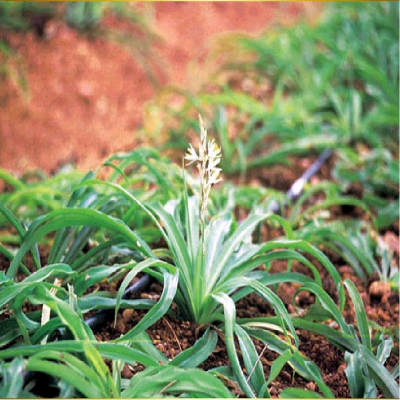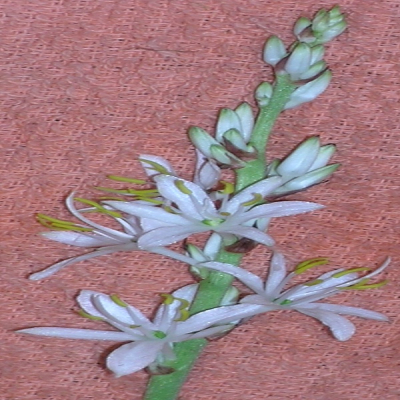Chlorophytum borivilianum
Family : Asperagaceae (Dracaenaceae)
Group : Aphrodisiac/spermatogenesis
Parts Used : Rhizome
Vernacular Names :-
| English | : | White musali |
| Malayalam | : | Vella musali |
| Hindi | : | Safed musli |
| Sanskrit | : | Musali |
| Gujarathi | : | Gholi musali, Janjaria |
| Tamil | : | Tanirureta,Kuli, Safed musli |
| Telungu | : | Kushelli |
Distribution and Habitat: The plant is observed in the valley of Himalaya, Satpuda Vindhya, Arawah, and in hilly areas of Bihar and Assam. It is also found in the parts of Rajasthan, Gujarat in some parts of Maharashtra
Botany: It is a small perennial herb with radial leaves. It perenates by fleshy root tubers. The root tubers are fascicled, sessile cylindrical, 1-8 in number, brown to black skinned and white after peeling. The tubers are 3-10 cm long at maturity.
- Leaves: Radical, 6-13 in number, spirally imbricate at the base, sessile with acute apex. The leaves are spreading horizontally; margins are wavy with parallel venation. It has a solitary scape, 15-30 cm long, terminal and unbranched.
- Flower: White, bracteate, pedicellate, arranged in alternate clusters of 3 flowers. The bracts are linear, papery and purplish. Perianth 6 and 3-5 nerved stamens 6 and anthers yellow, style longer than stamens, swollen at apex and ovary 3-lobed, globose and sessile.
- Fruit: A loculicidal capsule and seeds are black with angular edges.
Chemical constituents: Tubers are of great medicinal value containing the steroid sapoginine (1-2%) proteins (10-12%) and calcium to sorrie extent with some water soluble minerals. Tubers are fat free.
Uses: It is useful on Itla and vata. It is explained as vrishya, dhatuvardhak, sheet, madhur, Rasayana, slightly bite, healthier and energetic in Ayurveda. It is effective on fatigueness, daaha, and in blood purification. It is useful in certain diseases like renal calculus, dhupani, Sangrahani, ileucorrhoea. It is lactating, energetic to heart.
Agro technology:
Soil and climate: It requires warm and humid climate for optimum plant growth and tuber development. Porous soil with high organic matter content help in fleshy tuber development. A soil pH range of 5.0-8.0 is optimum.
Propagations: seeds and tubers.
Irrigation: Irrigation should be given as and when required during growth period to avoid any water stress. Sprinklers may be used for irrigation.
Manures and Fertilizers: Application of different sources of organic matter, FYM, vermicompost and poultry manure along with NPK @ 100: 80:80 kg/ ha has positive influence on growth and yield of safed musli. Micronutrient deficiency symptoms are common and combined application of Iron, Boron and Zinc improved vegetative growth, yield and saponin content of tubers.
Pests and Diseases: Its tubers are infected by Aspergillus species and Fusarium species during the storage of fleshy tubers. The crop is affected by (Colletotrichium chlorophyti, C. dematium) and rust (Uromyces loculiformis and U. clignii) and collar rot due to soil- borne fungal pathogen, Corticium rolfisii. Characteristic white cottony growth on the collar region of plant was observed in collar rot. Leaf spot is controlled by spraying carbendazim @ 0.15%.
Harvesting: They are ready for harvesting after 6 months of planting. Harvesting is done in December –January, when the natured leaves drop down.



